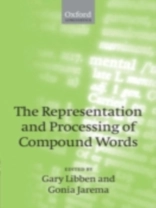This book presents new work on the psycholinguistics and neurolinguistics of compound words. It shows the insights this work offers on natural language processing and the relation between language, mind, and memory. Compounding is an easy and effective way to create and transfer meanings. By building new lexical items based on the meanings of existing items, compounds can usually be understood on first presentation, though – as, say, breadboard, cardboard, cupboard, and sandwich-board show – the rules governing the relations between the components’ meanings are not always straightforward. Compound words are segmentable into their constituent morphemes in much the same way as sentences can be divided into their constituent words: children and adults would not otherwise find them interpretable. But compound sequences may also be independent lexical items that can be retrieved for production as single entities and whose idiosyncratic meanings are stored in the mind. Compound words reflect the properties both of linguistic representation in the mind and of grammatical processing. They thus offer opportunities for investigating key aspects of the mental operations involved in language: for example, the interplay between storage and computation; the manner in which morphological and semantic factors impact on the nature of storage; and the way the mind’s computational processesserve on-line language comprehension and production. This book explores the nature of these opportunities, assesses what is known, and considers what may yet be discovered and how.
Gonia Jarema & Gary Libben
Representation and Processing of Compound Words [PDF ebook]
Representation and Processing of Compound Words [PDF ebook]
Koop dit e-boek en ontvang er nog 1 GRATIS!
Taal Engels ● Formaat PDF ● ISBN 9780191536489 ● Editor Gonia Jarema & Gary Libben ● Uitgeverij OUP Oxford ● Gepubliceerd 2005 ● Downloadbare 6 keer ● Valuta EUR ● ID 2273648 ● Kopieerbeveiliging Adobe DRM
Vereist een DRM-compatibele e-boeklezer












